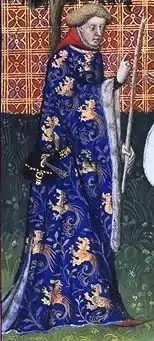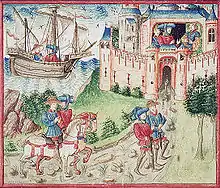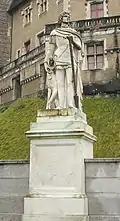Gaston III, Count of Foix
Gaston Fébus [also spelt Phoebus] (30 April 1331 – 1391) was the eleventh count of Foix (as Gaston III) and viscount of Béarn (as Gaston X) from 1343 until his death.
Lord of Bearn Gaston Fébus | |
|---|---|
| Born | April 30, 1331 |
| Died | August 1, 1391 L'Hôpital-d'Orion |
Notable work | Livre de chasse (Book of the Hunt) |
| Title | Count of Foix (as Gaston III), viscount of Béarn (as Gaston X) |
| Predecessor | Gaston II, Count of Foix |
| Successor | Matthew, Count of Foix |
| Spouse(s) | |
| Children | Gaston de Foix-Béarn, Yvain de Béarn, Bernard de Béarn, Gratien de Béarn |
| Parents |
|
| Signature | |
 | |

Early life
Gaston was born either in Orthez or Foix, the eldest son of Gaston II/IX (1308–1343). As the lord's eldest son, he was given the name, Gaston. He later adopted Fébus as a nickname. In its classic spelling, Phoebus, it is one of the names of the sun-god, Apollo, and is apt because of Gaston Fébus's golden hair. His native language was Gascon (a dialect of Occitan), but he was also fluent in French. He wrote a treatise on hunting in French, and an Occitan song, Se Canta, has been ascribed to him. One contemporary chronicler, Jean Froissart, records that he "very willingly spoke to me not in his native Gascon but in proper and elegant French".[1]
Count of Foix
Béarn had passed to the county of Foix in 1290. Fébus paid homage to the French king for his own county, but starting in 1347 he refused to give homage for Béarn, which he claimed as an independent fief, with its chief seat his stronghold at Pau, a site that had been fortified by the 11th century, which was later made the official capital of Béarn in 1464.
Starting in 1374, court minutes in the sovereign viscounty were dated with reference to the lord of Béarn. He established international diplomatic relations with Navarre, Castile and Aragon, taking advantage to a large extent of the weakness of the French crown. He started a policy of rapprochement to the realms to the south of the Pyrenees. He, for example, married Agnes, daughter of Philip III and Joan II of Navarre, with the acquiescence of the French king Philip VI.[2]
While Gaston eventually repudiated Agnes, he pursued the establishment of a Pyrenean realm under his leadership, and thus secure the control of the thriving commercial route of Toulouse-Bayonne. His intent to reinforce authority across all the area was halfhearted due to economic constraints.[2]
Although he designated the king of France as his successor, eventually that did not happen, since the newly established Estates-General of Béarn prevented it.[2] He was succeeded as count of Foix and sovereign viscount of Béarn by Mathieu of Foix-Castelbon.
A fortune won in battle
The House of Béarn-Foix was engaged in a long running feud with the House of Armagnac. In 1362, a battle was fought between the two noble houses at Launac. Fébus was victorious and succeeded in capturing his chief rivals, whom he ransomed for a vast fortune of at least 600,000 florins. This money was stored in the Moncade tower in Orthez, where Fébus also created a gallery of portraits and military trophies to commemorate the event.[3]
Castles
The constructions of Gaston Fébus all have in common the same plan whatever its surface and its location. The plan is as follows: a polygonal enclosure to which are built buildings forming an interior courtyard, a quadrangular tower straddling the curtain wall (pentagonal at the Château de Moncade), sometimes a second tower, as well as a ditch spanned by a drawbridge.
- Febusian constructions
.JPG.webp) The tower of the castle of Montaner
The tower of the castle of Montaner The tower of the Moncade Castle
The tower of the Moncade Castle.JPG.webp) The Castle of Mauvezin
The Castle of Mauvezin The Castle of Morlanne
The Castle of Morlanne The Gaston Fébus' tower (Castle of Pau)
The Gaston Fébus' tower (Castle of Pau) The Castle of Moncade
The Castle of Moncade
Records of Jean Froissart

In late 1388, the chronicler, Jean Froissart, visited the County of Foix and recorded the splendour of Fébus' court at Orthez.[4] He noted that Fébus describes the three "special delights" of his life as "arms, love and hunting".
Livre de chasse (Book of the Hunt)
Fébus was one of the greatest huntsmen of his day, and hunted his entire life – he died of a stroke while washing his hands after returning from a bear hunt. His Livre de chasse (Book of the Hunt) was written between 1387–1389 and dedicated to Philip the Bold, Duke of Burgundy.[5]
Recorded in the book are different stages of hunting different animals, as well as describing animal behavior, offering advice to less well-off gentry about how to enjoy hunting without bankrupting themselves, and is even sympathetic to the peasant poacher because he too has the hunting instinct.
It is the classic treatise on Medieval hunting, and was described by scholar Hannele Klemettilä as "one of the most influential texts of its era".[6] Some forty-four 15th and 16th century illuminated manuscripts survive, the most famous being that held by the Bibliothèque nationale de France, which has exquisite miniatures, illustrating the hunt.[7]
Marriage and children
Fébus married Agnès of Navarre (1334–1396), daughter of Joan II of Navarre and Philip III of Navarre in 1348. They had a son:
- Gaston (1361-1382), married Béatrice d'Armagnac (1362-1410), daughter of John II of Armagnac.
He was also the father of four illegitimate children:
- Garcia de Béarn, viscount of Ossau, husband of Anne de Lavedan;
- Peranudet de Béarn, died in childhood;
- Bernal de Foix died about 1381, first count of Medinaceli by his marriage to Isabel de la Cerda, lady of Huelva, Gibraleón and of Puerto de Santa María, the forefather of the dukes of Medinaceli;
- Jean de Béarn, also called Yvain de Lescar, was Fébus' favourite son, dying on 30 January 1393 without issue, of burns accidentally caused at the Bal des ardents.[8]
Betrayal of the Count's son

As Jean Froissart records, Fébus was betrayed by his son who also bore the dynastic name, Gaston, and who tried to kill his father using poison given to him by Charles II of Navarre. Fébus caught his son in the act and imprisoned him. In a subsequent violent quarrel, Fébus stabbed his son, who died.[9]
Following Gaston's death, Fébus had no legitimate descendants. In 1393, in Paris at a masquerade given by the Queen of France, Isabeau of Bavaria, one of Gaston Fébus's four recorded illegitimate sons, Yvain de Foix, was burned to death when his costume, along with the costumes of four others, caught fire from a torch at the Bal des Ardents.[8]
Posterity
Popular Culture
In 1839, Alexandre Dumas published a long story taking Fébus as its central character, in his novel Acté.
In the 20th century, the novel by Myriam and Gaston de Béarn, La Vie fabuleuse de Gaston Phœbus (1959), was a great success. This romantic trilogy was adapted to television in 1978 in Gaston Fébus: the Lion of the Pyrenees.
In March 2020, the ethnologist and ethnographer Emmanuel Larrouturou revealed that the calligraphy of Gaston Fébus' signature is an ingenious graphic device revealing, by superimposing loose sheets, various forms related to totemism.[10]
See also
Further reading
- Lagabrielle, Sophie (2011), Gaston Fėbus : Prince Soleil (1331-1391) (in French), Paris: Ėditions de la Rmn - Grand Palais, ISBN 978-2-7118-5877-4
- Pailhès, Claudine (2007), Gaston Fėbus : Le Prince et le diable (in French), Paris: Ėditions Perrin, ISBN 978-2-262-02355-3
- Tucoo-Chala, Pierre (1983), Gaston Fėbus : Un grand prince d'Occident au XIVe siècle (in French), Pau: Ėditions Marrimpouey, ISBN 2-85302-096-7
- Tucoo-Chala, Pierre (1993), Gaston Fėbus : Prince des Pyrénées (1331-1391) (in French), Pau: Ėditions Deucalion, ISBN 2-906483-43-5
References
Notes
- Paul Cohen, "Linguistic Politics on the Periphery: Louis XIII, Béarn, and the Making of French as an Official Language in Early Modern France", When Languages Collide: Perspectives on Language Conflict, Language Competition, and Language Coexistence (Ohio State University Press, 2003), pp. 165–200, at 189 n. 40.
- Adot Lerga, Álvaro (2005). Juan de Albret y Catalina de Foix o la defensa del Estado navarro (1483-1517). Pamplona/Iruñea: Pamiela. pp. 62–63. ISBN 84-7681-443-7.
- Fowler, Kenneth (2001). Medieval Mercenaries: Vol. I The Great Companies. Oxford: Blackwell. pp. 61–7. ISBN 0631158863.
- Vernier 2008, pp. 111-118.
- d'Athenaise 2002, pp. 4-7.
- Klemettilä 2015, p. 4.
- "Archived copy". Archived from the original on 2011-07-27. Retrieved 2010-01-28.CS1 maint: archived copy as title (link)
- Tuchman 1978, pp. 530-532.
- Tuchman 1978, pp. 360-61.
- Larrouturou, Emmanuel (March 2020). "FEBUS' SIGNATURE / DECIPHERING TOTEMS / COMPENDIUM OF ETHNOGRAPHIC VISUAL ESSAYS, MARCH 2020". Cromlechs Ossau. Retrieved June 1, 2020.
Sources
- d'Athenaise, Claude, ed. (2002), Le livre de chasse de Gaston Phėbus (in French), Paris: Bibliothėque de l'Image, ISBN 2-914661-03-7
- Cummins, John The Hound and the Hawk: The Art of Medieval Hunting Publ. Weidenfeld & Nicolson; New paperback edition (18 Jan 2001) ISBN 978-1842120972
- Klemettilä, Hannele (2015), Animals and Hunters in the Late Middle Ages: Evidence from the BnF MS fr. 616 of the Livre de chasse by Gaston Fébus, Museum Studies, Abingdon-on-Thames: Routledge, ISBN 978-1-13-884233-5
- Tuchman, Barbara W. (2007) [1978], A Distant Mirror: The Calamitous 14th Century, ISBN 9780345289308
- Vernier, Richard (2008), Lord of the Pyrenees: Gaston Fėbus, Count of Foix 1331-1391, Woodbridge: Boydell Press, ISBN 978-1-84383-356-7
- Febus Avant! Music at the Court of Gaston Febus, Count of Foix and Bearn (1331-1391); Huelgas Ensemble, Paul Van Nevel; Sony, 1992.
External links
| Wikimedia Commons has media related to Gaston III, Count of Foix. |
| Preceded by Gaston II & IX |
Count of Foix Viscount of Béarn 1343-1391 |
Succeeded by Matthew |